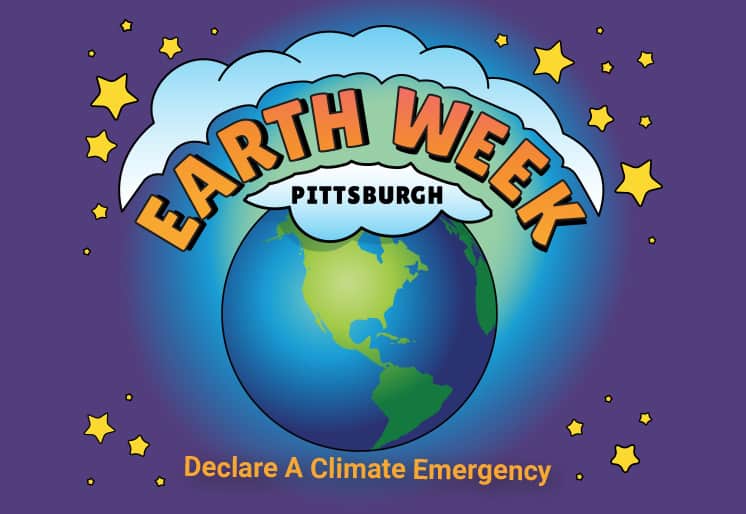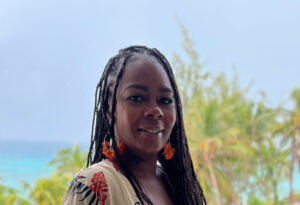It was April 6, 1970, the day Raymond and Lillian welcomed a healthy baby girl into this world. It was a different time back then, in many ways, and then again perhaps it feels like time has stood still. Just 16 days after that child was born, me, a movement was “born” as well. Today we celebrate it as Earth Day.

Those parents taught me from a young age to care for our planet and opened my eyes to the blessings of the world around us. My mother Lillian would have me sow seeds, nurture that bountiful vegetable garden and appreciate the beauty of nature by caring for the tender perennial bulbs that brought beauty and fragrance to our home. My dad Raymond would take me from an early age on countless explorations to find the perfect fishing spot, sometimes along the shorelines of the locks and dams, other times on the serene waters of our state parks. And trails would be navigated for hours
We had more times of “the fish weren’t biting today” or “the big one got away” (it was always catch and release) and maybe a growing season didn’t quite yield the greatest crop, but it certainly didn’t matter. What did matter were these moments of appreciating the outdoors together, connecting with one another, sometimes sharing aspirations, sometimes sitting in silence. And perhaps unknowingly, or intentionally, these parents instilled an everlasting respect, admiration, and love for our environment on me from these very tender early years…that carried through to this 50-year celebration of Earth Day today.
My career has been dedicated to protecting and conserving the environment, then developing programs, and advocating for policies that addressed environmental harms that impact the community’s health. For over a decade I worked for a land trust, Western PA Conservancy. Traversing large tracts of land across the commonwealth, negotiating deals with landowners and ultimately acquiring property to be forever stewarded by our state parks, forests and game lands. The parcels provide habitat to rare and endangered species, protect the headwaters of designated streams, open landscapes for recreational use, ensure farmland is protected in perpetuity, and in some instances make the land available for remediation from the scars of the past such as the acid mine drainage left behind from decades of coal mining. The acreage amounted to the tens of thousands, but the wonderful people met along the way a smaller number, but no less significant. For they had a deep connection to the land and wanted to preserve it.
During that time this young professional gained insight into advocating for our planet and people, starting with a trip to Washington, DC. My first experience in Congress, I shared stories of this conservation work and spoke to members of the House and Senate about the need to permanently authorize the Land and Water Conservation Fund. The purpose to provide for recreational opportunities, protecting national parks, safeguard our drinking water supplies, and keep working forests and ranches in sustainable operation instead of subdivided and developed. And to this day, Congress continues to divert money (billions of dollars) from this fund…To take action, sign this petition.
In the early 2000s, I became increasingly aware of climate change and the threat looming. How would this impact my babies and the generations to come? What kind of world would I be leaving for them? And subsequently, there began the great concern about fossil fuel development. I left the land trust at a time when unconventional gas drilling (fracking) was beginning to take hold in earnest, and concerns were mounting, in communities across the state. Coalitions were forming, grassroot efforts were mobilizing, but would it be enough?

I am well into motherhood and introducing my own children to the wonder of the outdoors. Attention is now drawn to pressing needs in a region and through a new lens. I was hired to run Women for a Healthy Environment (WHE). A group of passionate and courageous women, many of whom are still on the board today (including its tenacious board chair), coalesced to create this nonprofit, focused on educating individuals about environmental risks to human health, providing action steps communities can take to mitigate those risks, and advocating for solutions that better protect the region. By translating scientific information for general consumption, WHE would empower people to make healthy choices and advocate for change for a better tomorrow for all.
WHE’s mission is centered in environmental justice communities and includes an emphasis on addressing healthy housing principles, as well as creating eco-healthy spaces in schools and early learning centers. This work helps educate and inform those who care for and teach children, by sharing policies and best practices that create a healthier environment. Since 2010 WHE has directly educated over 25,000 individuals through workshops and community programming (including distribution of thousands of filters that remove lead from drinking water) and provided technical assistance to nearly 200 schools and early learning centers.
By collecting and analyzing data, WHE has been instrumental in leading conversations with elected officials regarding environmental health policies needed at the local and state levels of government. Coalition-building has been in integral part of that work, whether it’s working with parties committed to advancing green and healthy school initiatives, focusing on primary prevention of lead exposure, or collaborating on cancer and the environment priorities. We must all agree that there are still critical, daily environmental health threats that must be addressed collectively. History informs us that it takes the whole community working together to protect those most at risk, our children. This isn’t often accomplished in a single year, but with a community-focused approach and engagement from many, we can achieve success.
As now a seasoned professional, I could hear the numbers play out hundreds of times in my head – Do you know over 85,000 chemicals (including known carcinogens) have been introduced into commerce since 1976, when the Toxic Substances Control Act (TSCA) was passed? How many of those have been tested for safety? Only 200. Change was long overdue. One of the organization’s first challenges was TSCA reform, and that meant spending hours in DC and engaging constituents. Oftentimes I would be told by staffers that it was nice to see some local folks, because the chemical industry’s lobbyists just walked out the door. In June 2016, The Frank R. Lautenberg Chemical Safety for the 21st Century Act ensured mandatory requirement for EPA to evaluate existing chemicals with clear and enforceable deadlines and consistent source of funding for EPA to carry out the responsibilities under the new law. It wasn’t perfect, but it was a win.
And now in 2020, more wins are needed, to date over 90 environmental regulations have been “rolled back” under the current administration. This will no doubt continue to have an impact on our health, including less stringent regulations focused on air quality standards and more greenhouse gas emissions contributing to climate change. (Yesterday, the American Lung Association rated our region again with a failing grade in the “State of the Air” report.)
We have an opportunity at the state level to implement sound policies that protect public health. Bills have been introduced to require radon testing in schools, funding for environmental hazards in schools, and (prior to COVID-19) the Governor’s budget had called for money to be allocated for lead and asbestos testing in schools, but we can do more. The Joint State Government Commission’s “Lead Exposure Risks and Responses in Pennsylvania: Report of the Advisory Committee and Task Force on Lead Exposure” cited many policy initiatives that should be introduced, and passed, at the state level to ensure that no child continues to be poisoned by lead in the commonwealth.
At a time when we need to focus on sustainability and how to better protect our planet, we must have incentives that make us less reliant on fossil fuels. This woman now lives in a community that will soon house the largest injection well in the state. Not only will the community be impacted by hazardous air pollutants from truck traffic, concerns for water contamination and seismic activity are real. Well pads are becoming more common in Allegheny County and there continues to be a health concern. In June 2019, the Physicians for Social Responsibility released a “Compendium of Scientific, Medical, and Media Findings Demonstrating Risks and Harms of Fracking.”
We have become a society of habit and convenience, unfortunately relying daily on plastic. (In order for plastic pellets (nurdles) to be produced, it must rely on the “wet gas” from fracking.) The images of harmful impacts to sea turtles and whales’ bellies filled with plastic are alarming and dreadful, but how that plastic impacts human health is of equal concern. Plastic contains endocrine disrupting chemicals (EDCs), which are chemicals that mimic or interfere with the natural hormones in our body. And that is dangerous. We see girls who are pre-pubescent at a much younger age, for example, and obesity and its connection to EDCs is being carefully studied.
Rachel Carson was an early pioneer addressing these EDCs. She challenged humankind to assess the practices that were destroying our natural world and impacting human health. Her early research on pesticides and other synthetic chemicals has been a cornerstone for Women for a Healthy Environment’s focus on environmental risk factors. We have actively spoken about and campaigned on the dozens of chemicals undisclosed in cleaning products and unregulated in personal care items, the harmful impacts of pesticides, and we are equally concerned about toxics in other household consumer goods and those used in schools and early learning centers, such as cleaning supplies and artificial playing surfaces.
I came across this picture (below) of the first Earth Day celebration in New York City. It stopped me in my tracks, and I wept. As you can see, this image could have very well been taken this week. The coronavirus (COVID-19) pandemic continues to demonstrate how we are globally connected, one to the other. We must continue to let science lead us in national, statewide and local decision-making. This pandemic has also demonstrated the continued injustices faced by our communities of color. We must put aside differences, put aside corporate and political greed, to focus on an agenda that is inclusive and supports all. We must continue to value and address health inequities as the crisis that it is, daily impacting those most in need, where affordable housing, and access to healthcare, food, transportation, and a living wage are critical. This pandemic has also shown us what a world looks like with less pollution – cleaner skies and clearer waters. I urge us to use this time, these lessons-learned, and not turn our back on this moment

Earth Day 1970
There are several small actions we can all commit to this Earth day, choose one or choose all: 1) complete your Census ballot 2) exercise your right to vote 3) become engaged in your local community and connect to the natural world 4) commit to supporting your small businesses 5) support your favorite nonprofits working to protect health and the environment 6) visit your local farmers market 7) follow the “R’s, especially related to plastics – refuse, rethink, reduce, reuse, recycle 8) eat for the planet 9) use energy wisely, including at home, such as installation of solar power 10) make informed consumer decisions and ask is this sustainable?
As I, and Earth Day, celebrate a half of a century this month, I am reminded, and optimistic, in the power of the people that I have the great fortune to intersect with day in and day out, that we are all committed to making this a healthier and safer place for all to live, work, and play. As a mom and a public health advocate, I pledge to continue to promote a healthier environment for all, especially our children. We will never compromise our work because it is the path of least resistance. Our first question will continue to remain “How does this benefit/or potentially harm the health of the child?”
In closing, I want to express my hope. I am hopeful for the resiliency, fortitude and determination shown by our youth, including my high school senior who entered the world during the aftermath of 9/11. This generation is committed to making the world a better planet. They have stood beside me in marches for our environment. They are committed to addressing the climate change crisis, recognizing the many public health impacts from a heating planet.
They are willing to confront lawmakers and inform them of the dangers of environmental rollbacks and the need to invest in clean energy, and they are also anxious to draft good policy and programs that protects the public’s health. Our interns and staff remind me of this each day, and year, that I have the good fortune of working alongside them. We are in good hands, let them lead the way…and Happy 50th Earth Day… we’ve got a lot more work to do.
Michelle Naccarati-Chapkis
Executive Director
Women for a Healthy Environment





